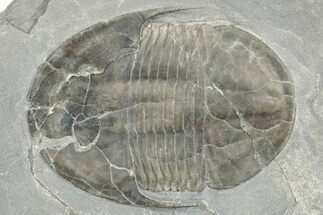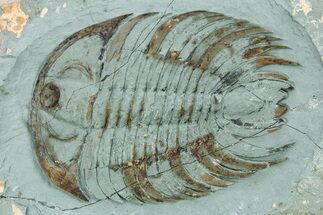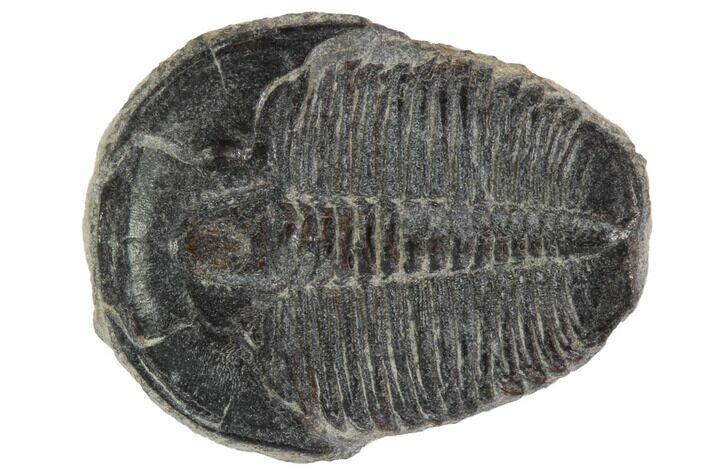This Specimen has been sold.
.7" Elrathia Trilobite Fossil - Utah
This is a .7" long Elrathia kingii trilobite fossil from the 505 million year old Wheeler Shale of Utah. It has both cheeks tightly attached and is presented in a small plastic case.
Elrathia is a famous genus of trilobite that had an amazing ability to thrive where other ancient animals could not: they patrolled the deep, muddy waters offshore of the ancient continent Laurasia.
While other organisms enjoyed the good life of sunshine and warmth along equatorial shorelines, Elrathia filled the dark benthic zone on the border of very little oxygen and none at all.
Trilobites, one of the earliest arthropods, first appeared in the Early Cambrian, about 521 million years ago. They are relics of the Cambrian Explosion. Elrathia proves that adaptation to such inhospitable environments had developed as early as the Middle Cambrian (509-497 million years ago). The size and prolific presence of Elrathia kingii is extraordinary for an inhabitant an exaerobic world. There must have been a significant food web, which is an ecological conundrum at this time.
Elrathia kingii lived in a sunless world whose primary producers may have used energy sources that still remain a mystery. Rapid burial and underwater landslides helped to preserve a snapshot of their life on the edge. Trilobites were tough, dominating, and diverse--yet, they did not make it beyond the mass extinction at the end of the Permian, about 250 million years ago.
The Wheeler Shale, a remnant of an ancient embayment where the ocean intruded into Utah, is perched in the strikingly arid and steep terrain of the House Range. Walcott awarded the area's limestone rocks and clay their title, but long before Walcott, Native Americans in the region regarded the trilobites with respect and appreciation. Today, several commercial quarries operate in the Wheeler Shale: this includes U-Dig, where you can dig your own trilobites.
While other organisms enjoyed the good life of sunshine and warmth along equatorial shorelines, Elrathia filled the dark benthic zone on the border of very little oxygen and none at all.
Trilobites, one of the earliest arthropods, first appeared in the Early Cambrian, about 521 million years ago. They are relics of the Cambrian Explosion. Elrathia proves that adaptation to such inhospitable environments had developed as early as the Middle Cambrian (509-497 million years ago). The size and prolific presence of Elrathia kingii is extraordinary for an inhabitant an exaerobic world. There must have been a significant food web, which is an ecological conundrum at this time.
Elrathia kingii lived in a sunless world whose primary producers may have used energy sources that still remain a mystery. Rapid burial and underwater landslides helped to preserve a snapshot of their life on the edge. Trilobites were tough, dominating, and diverse--yet, they did not make it beyond the mass extinction at the end of the Permian, about 250 million years ago.
The Wheeler Shale, a remnant of an ancient embayment where the ocean intruded into Utah, is perched in the strikingly arid and steep terrain of the House Range. Walcott awarded the area's limestone rocks and clay their title, but long before Walcott, Native Americans in the region regarded the trilobites with respect and appreciation. Today, several commercial quarries operate in the Wheeler Shale: this includes U-Dig, where you can dig your own trilobites.
SPECIES
Elrathia kingii
LOCATION
Antelope Springs, House Range, Utah
FORMATION
Wheeler Shale
SIZE
.7" long
CATEGORY
SUB CATEGORY
ITEM
#97072
We guarantee the authenticity of all of our specimens.
 Reviews
Reviews












